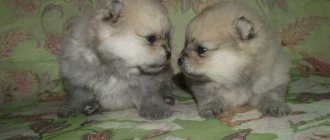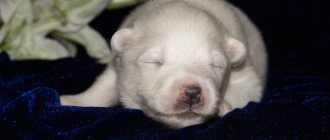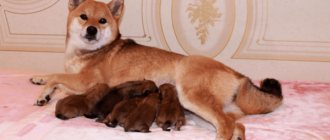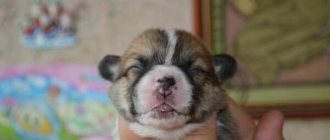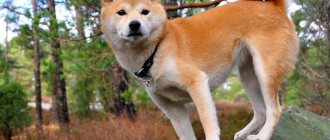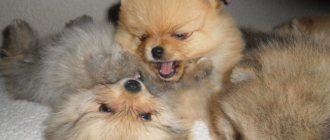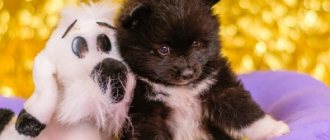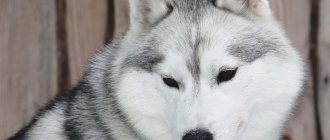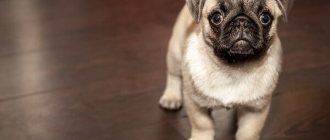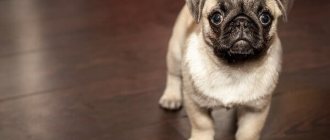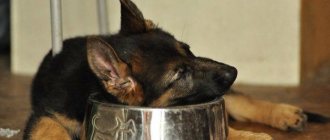The Rottweiler breed can hardly be classified as a family breed.
Therefore, you should think several times before purchasing.
It is not suitable for everyone due to their personality traits.
This breed is more important than any other owner, his leadership qualities and patience.
What kind of care is required for a puppy and how to raise it correctly?
What newborn puppies look like
Rottweiler babies are born black, with tan marks already visible on their fur..
The dogs are blind and can crawl. Their ears are small and short, pressed to the head.
The muzzle is short, the nose is either black or with pink spots.
The paws are still small and weak, but the claws are already clearly visible on them . The puppies' bellies are also either black or pink.
Description of the pet
The Rottweiler's constitution is balanced.
The height of an adult male can reach 68 cm, and that of a female – 63 cm. Body weight varies from 42 to 50 kg. A photo of a dog best demonstrates what a Rottweiler looks like. The standard is described as follows:
Head. It is of medium size, the bump on the back of the head is quite pronounced, and the ears are characterized by a wide set. The muzzle is narrowed with a wide lobe and round nostrils.
Ears. They have the shape of a triangle and are usually docked.
Neck. It is distinguished by its strength and muscularity. Rottweilers have a straight back that extends into the lumbar girdle. The croup is medium in size and widened.
Tail. In this breed it is stopped.
Limbs. Strong paws are set wide, and the elbows are pressed to the body.
How it develops by month to year (table)
| Development stage | Age (weeks) | Height | Weight | Description |
| Initial period | 1-7 | 10-20 cm | 1-3 kg | At this age, the Rottweiler only needs to satisfy its physiological needs: mother's milk, sleep, warmth. |
| Adaptation | 4-7 | 20-22 cm | 3.5-4.5 kg | During this period, the puppy already gets to know the world, plays with its mother and brothers, and gets acquainted with a person and his smell. |
| Socialization | 7-12 | 47-48 cm | 14-17 kg | Now it is important to introduce the dog to other animals and objects. It's time to start training your pet. Make sure your puppy avoids stressful situations. |
| Domination | 12-17 | 49-51 cm | 17-23 kg | This is the time when the dog begins to show his character and becomes disobedient. Don't miss this moment, take the situation into your own hands and show who's boss. |
| Independence | 4-8 | 56 cm | 24-31 kg | The puppy shows its complete independence. This is the period when the owner needs to continue to establish himself as a leader in the eyes of the dog. |
| Period of fear | 7-14 | 60 cm 64 cm 66 cm | 32-35 kg 34-40 kg 36-46 kg | The puppy begins to become afraid of unfamiliar objects, people and sounds. Calm and pet your pet in a timely manner. He should feel your calmness. |
| Transition period | 1-4 years | 67 cm | 50 kg | The dog is entering adolescence. He may become unruly again and try to dominate. Don't let him do this, so that such behavior does not become entrenched in his character. |
Veterinarians' opinion
Veterinarians are confident that “cutting off” a dog’s tail is not only inhumane, but also not functional. The procedure has long lost its relevance.
Moreover, animal psychologists believe that, having lost its ears and tail, the Rottweiler loses contact with the outside world. These body parts are important “attributes” of dogs that help them communicate. Even a slight deviation of the tail to the side is a special signal.
Doctors also believe that the animal feels and remembers pain, even if the operation was performed as a puppy. The procedure causes a lot of stress, and stress leads to increased aggressiveness.
One way or another, the final decision on whether to dock a pet can only be made by the owner. It is first important to weigh the pros and cons and familiarize yourself with the arguments of breeders and veterinarians.
Main varieties
There are four varieties of the Rottweiler breed approved by the standard:
- German (Germanic).
- American (shown in the photo).
- English.
- FCI (Federation Cynologique Internationale).
NOTE!
The breeder of the American and English Rottweiler took the German type as a feature, so these breeds are similar to each other, and differ only in character.
The German Rottweiler is the oldest of all varieties. Its parameters are closest to the International Standard.
Ear cropping
The operation is not complicated, it has been carried out for a long time, so veterinarians know all the intricacies. The main thing is to ensure the sterility of the instruments and the procedure site. You can invite a doctor to your home.
Ears are always cropped using local or general anesthesia. The Rottweiler is fixed on a flat surface (operating table, couch): the dog is laid on its side, the hind and front limbs are tied, and a hygienic fabric muzzle is put on the muzzle.
An inhalation tube is installed for artificial ventilation and tongue control. The ears are placed on the table and secured with patterns along the cut line. Metal forms not only serve as a template, they reliably clamp the vessels of the cropped ears.
The skin is moved to the base, an incision is made with a scalpel according to the attached template. The cut edge is treated with an antiseptic, stitches and a corrective bandage are applied.
Features of puppies from Germany
Since this breed was first described in Germany, it has its own characteristics associated with the tasks performed by the Rottweiler: driving livestock, farming and guarding the house.
In our time, Rottweilers have also adopted the associated character traits.
Puppies of the Germanic variety are calmer, focus their attention better, and they also skillfully work in tandem with a person.
Regarding physique, German Rottweilers are more muscular and have a layer of subcutaneous fat . Even from a young age, puppies are distinguished by their strength, intelligence and intelligence.
Rottweiler health
Like other dog breeds, the Rottweiler suffers from various diseases. The most common ailments:
- congenital dislocation of the elbow and hip joints;
- inflammatory lesion of the bone marrow of a purulent nature;
- disorders of the adrenal glands;
- heart disease, caused by narrowing of the aorta;
- retinal atrophy;
- cataract;
- von Willebrand-Diana disease;
- expansion of the stomach cavity with stretching of its walls.
In addition, some representatives experience disturbances in the functioning of the nervous system and kidney problems. The dog may also become bald.
How to care?
The first few days at home with your puppy will be hectic, but you will quickly get used to the tasks of caring for your puppy.
Prepare in advance for where and how you will vaccinate your dog.
Rottweilers are susceptible to parvovirus, so be careful with your puppy during the first few weeks.:
- Immediately begin to accustom your puppy to cleanliness within the walls of the house. Teach your puppy to “do things” first in a special place - this could be a crate or just a diaper placed in one place.
- Always walk your puppy at the same time so that he gets used to it. Keep an eye on him both at home and on the street, don’t let him play pranks.
- Start training your Rottweiler from the first days in the house. Teach him simple commands first, then increase the level of complexity.
- Don't forget that your dog needs to be socialized around other dogs.
Just love your dog, pet and hug often, but don’t indulge in pranks and whims.
To care for your Rottweiler, you will need a special cage to teach it to be clean, stain and odor removers, a soft collar with tags and a leash, bowls for food and water, and various toys for the puppy to spend time with .
You will also need to brush the puppy twice a week, do not forget to clean his ears, trim his nails, and purchase special bones so that the dog can brush his teeth.
You don't need to wash your Rottweiler often, only if it is too dirty..
The water temperature should be no higher than 30 degrees.
Breed care
It is best to keep a Rottweiler in a spacious enclosure with a warm booth in the courtyard of a private house. When kept in an apartment, the dog requires regular walks lasting at least one hour. For normal development, the puppy needs constant physical activity.
Care activities that begin in early childhood:
- The fur is combed out every week; during shedding, the coat is combed daily;
- water procedures are carried out as needed, usually twice a year;
- after each walk, wipe the paws with a damp towel to remove debris and dirt;
- check the condition of the eyes and ears weekly; if there is an increased amount of discharge or inflammation in the ear openings, contact a veterinary clinic;
- Every week the teeth are brushed with a special paste; to reduce the risk of plaque and tartar, the animal is given bones;
- claws are trimmed as needed, since the Rottweiler grinds them off on a hard surface during walks.
First feeding
The first complementary foods are introduced when the puppy is three weeks old..
It consists of puppies consuming warm cow's milk, which should be added with a chicken egg.
In the first days, one egg is required per glass of milk, and in subsequent days, an egg per 300-300 g . Instead, you can use special breast milk substitutes that are sold in pet stores.
The feeding process should be as close as possible to the natural process.
To do this, the puppy is taken under the chest so that he can “knead” with his front paws and lean on something with his back paws, as when sucking his mother’s milk.
IMPORTANT!
Puppies should be fed twice a day, and then gradually increased to four times a day.
The portion at the beginning of complementary feeding is 100 g, and by the age of one month it reaches 400 g.
Character
This dog quickly gets used to its owner, so it is considered a monogamous dog. The most important characteristic of the Rottweiler is aggressiveness at the slightest danger.
Under normal conditions, this is an obedient, calm family member. But if you don’t deal with it, he becomes jealous and touchy. As a rule, males are more independent than females.
During play, the pet can accidentally injure small children. Therefore, it is better for parents of babies to consider another breed. Moloss is not suitable for those who lead a sedentary lifestyle.
How and what to feed
The puppy's nutrition should be balanced and healthy . The most important thing to follow when feeding a Rottweiler in the first weeks is to give it what the breeder fed it.
In the future, you can gradually switch your dog to the food you need.
If you do not have time to prepare balanced natural food, then specialized food is an excellent replacement.
When choosing food for your pet on the shelves of a pet store, you should remember:
- Don't skimp on food. Very often, cheap food is low-quality food for a dog. It will not be able to provide the dog with the entire range of necessary vitamins and macroelements.
- Choose food that is suitable for your puppy's weight, age and breed.
- Before buying food, read the composition and contents indicated on the packaging.
- The first time, take some food. This way you can quickly replace it if it doesn't suit your puppy.
If you choose dry food rather than canned food, make sure your dog gets enough fluids.
If your choice fell on natural food, then this also has its own aspects and characteristics.
The diet should contain liquid dishes, and the food itself should be at room temperature.
Make sure your dog's diet is low in calories because Rottweilers are prone to obesity.
Obesity at a young age will lead to problems with bones and joints that have not yet formed and become deformed under the influence of excess weight.
Small puppies can be fed porridge with pieces of raw beef, milk, cottage cheese with sour cream and eggs in different types.
You can also give minced meat after dousing it with boiling water. Do not give all products at once, alternate and introduce gradually over three months.
From four months you can diversify your diet with new cereals and fresh vegetables.
Remember that if at 1-2 months the puppy ate 5-6 times a day, now you need to gradually reduce the number of meals, first to three, and then to two.
Natural food should contain:
- Lean meat and offal.
- A variety of cereals (no more than 30% of the total volume).
- Eggs.
- Sea fish without bones.
- Vegetables and vegetable broths.
- Fruits (be careful and always watch the dog’s reaction).
Don’t forget that puppies should absolutely not be given sweets, flour, spicy, pickled or fatty foods. Also avoid legumes, potatoes, long bones and cabbage in their diet.
Physiological processes in the dog's body
Biochemical processes
There are only two pigments in the dog’s body, which are found in the skin and hairs of the animal:
- pheomelanin - responsible for yellow color and its variations: red, red;
- eumelanin is responsible for the black color, which in its mutation form provides a brown color of varying intensity.
The pigments that determine a dog's color are located inside each hair. Their quantity, a certain color and the shape of the granule in which they are contained determine the color of the pile.
Genetic processes
A gene is a hereditary unit that conveys the characteristic characteristics of a breed.
Genotype is the basis of a dog’s body, a combination of hereditary factors and all genes.
Phenotype is the color of an animal formed by its genotype.
An allele is a state of the same gene under the influence of other genes.
Each gene is assigned its own letter designation: A, B, C, and so on. Let's look at the main genes that are responsible for all colors in Rottweiler dogs:
- at – responsible for the development of tan spots;
- asa – promotes the manifestation of non-standard black-and-white color;
- B – responsible for the appearance of black;
- b – promotes the appearance of a non-standard brown color in tan marks;
- C – full color of normal intensity;
- D – responsible for pigmentation density;
- E – promotes uniform distribution of black color throughout the animal’s body;
- Em – promotes the appearance of non-standard blackness of tan spots;
- g – is responsible for blocking age-related lightening;
- kbr – promotes the manifestation of non-standard brindle color;
- k – responsible for the location of genes;
- s – promotes the appearance of white spots.
If you liked the article, please share it with your friends and like it.
First vaccinations and at what age are they given?
In general, Rottweilers should be vaccinated against the following diseases::
- Rabies.
- Parainfluenza virus.
- Adenovirus.
- Parvovirus enteritis.
- Leptospirosis.
The first vaccination is given to the puppy at the age of 6-8 weeks..
This is usually done by breeders, so most likely your puppy will already have his first vaccination.
Booster vaccinations will be needed every three weeks until the puppy is 20 weeks old.
After 20 weeks to 2 years of age, revaccination is done against plague, parvovirus and parainfluenza virus.
Feeding
For a Rottweiler to live long and happily, a balanced diet is necessary. The diet of young shoots should include porridge, cottage cheese, chopped beef, eggs, and vegetables (except cabbage).
For adults, flour products, pasta, fish, offal, and fruit are added to the menu. The bowl should be double - for water and food.
You can consider the option of dry food. In this case, choose only reliable brands - German Wolfsblut, French Royal Canin. Be sure to treat your dog with a vitamin complex.
How to stop biting
At a young age, puppies do not yet understand how hard they bite, but if you watch two small dogs playing, you will see that it stops when one bites the other too hard and he, in turn, yelps in pain.
Use this tactic. Play with your puppy until he bites, then yelp loudly, imitating a dog squeal .
After that, get up and stop playing with him, showing him that you can’t behave like that.
Do not pull your hand away sharply, but rather relax while biting . Pulling away will awaken the dog's hunting instinct, and it will begin to attack the hand even more aggressively.
Start playing with your puppy again. If this behavior happens again, yelp again, scold him, and stop playing.
Do not repeat this too often, three times every 15 minutes will be sufficient.
Between games and bites, if the puppy licks you and tries to please you, reward him.
Also, if yelping doesn't work, then in addition to stopping the play, ignore the puppy for about 20-30 seconds. This will let him know that what he is doing is wrong.
You must convey to him that you can only play carefully and for this he should be praised, but otherwise not.
Possible complications
The most common problem after cupping is scarring. Unsightly healed edges of the ears or tail make the dog less attractive.
When using non-sterile devices, blood poisoning and the appearance of an abscess at the incision site may occur. Any inflammation is a bait for infections, because local immunity is sharply weakened.
Interesting! It is believed that an animal with a docked tail is less sensitive and more aggressive. The dog cannot show emotions like other dogs, so it has poor contact with others.
Price range
Before purchasing a Rottweiler puppy, ask yourself what you need it for. The fact is that the price of this breed depends on its purpose.
Puppies can be divided into three types:
- Pet class.
- Breeding class.
- Show class.
If you just need a puppy for yourself, to protect your house or apartment, then a representative of the pet class is quite suitable.
Such dogs have slight deviations from the standard, so they are not suitable for participation in exhibitions, or for breeding, that’s all..
The price of such puppies is 200-300 dollars, or translated into rubles - 13-19 thousand.
If you dream of breeding Rottweilers, then get a breed of breeding class. The minimum price for such puppies starts from 20 thousand rubles. The better the dog's parents, the higher the price.
The show class includes only the best, so-called elite, Rottweiler puppies . They have every chance to make a show career. Such dogs are very expensive.
The price for them starts from two hundred thousand rubles and ends at six hundred thousand rubles. When buying such a puppy, you need to be absolutely sure of the integrity of the breeder and the correct execution of documents.
It would also be a good idea to compare the puppy with the breed standard yourself, so as not to be deceived..
Popular colors
Deviation from the norm of color is a defect. Such dogs cannot participate in exhibitions, but are very popular with ordinary owners.
Common colors among Rottweilers include red, golden , brown, black without tan and albino. These colors appear either due to a genetic abnormality or are an inheritance from ancestors.
Dishonest breeders use such dogs, cross them and pass them off as unique, raising their prices several times over.
Dogs of non-standard color differ from others not only in coat color, but also in size, shade and tan boundaries . It may be completely absent on the face, or it may be lighter and have white spots.
How to choose?
If this is your first Rottweiler, then it is better to choose a female - she is more obedient and less aggressive, but they are wary of representatives of their own sex. They also go into heat, pregnancy and childbirth.
It’s worth choosing a male dog if you are 100% confident in your leadership qualities.
Evaluate the appearance of the Rottweiler when choosing. He should have clean eyes, nose and ears, and his limbs should be powerful. The coat should not curl, the tan marks should be symmetrical.
Watch your puppy play and interact with other dogs - this is how you will learn his character.
Take a calm and balanced puppy, not a shy one . This will be difficult to train and train.
Choose a puppy from a litter of no more than six and no crossbreeds. Mother must be no more than 8 years old.
Why is the tail docked?
Nowadays, Rottweilers with regular tails are quite common, but previously, due to the fact that they performed various dangerous tasks, their tails were docked to reduce the risk of injury from other animals.
Currently, tail docking is an optional procedure . It is done only to improve the appearance of the dog.
Cupping is usually done within 10 days after birth, while the vertebrae have not yet ossified.
